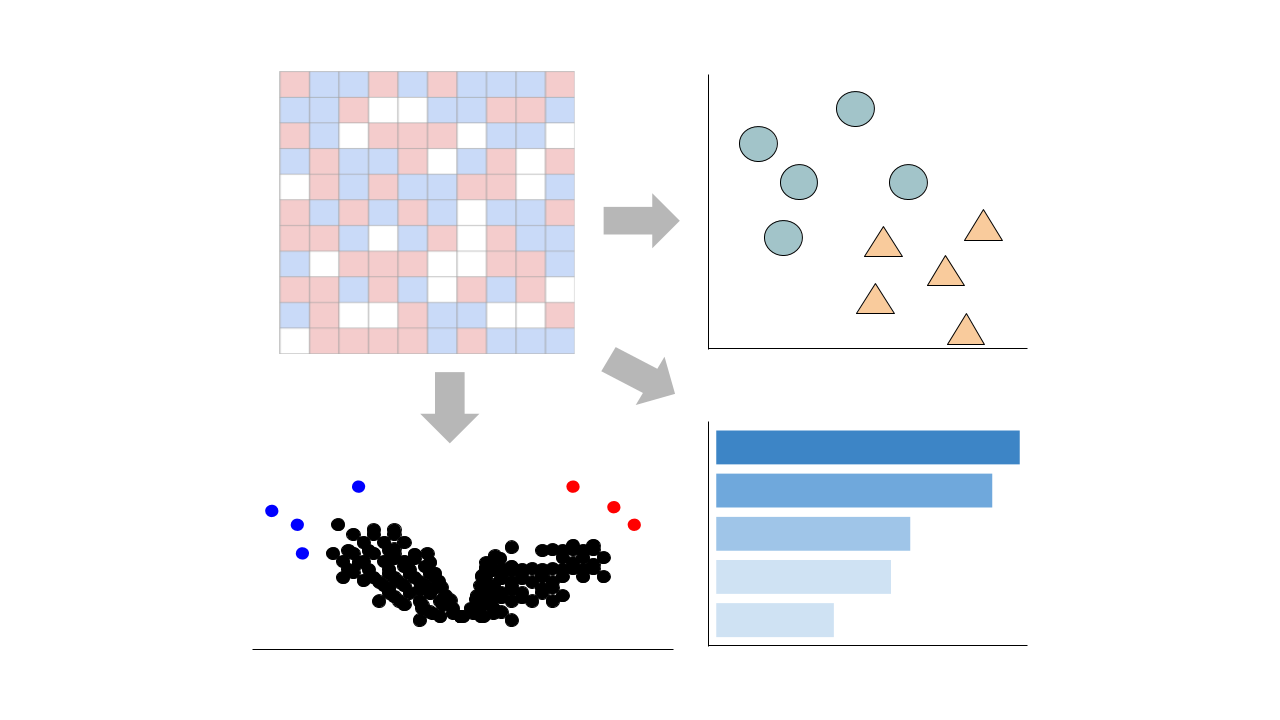 Gene counts are sourced from ARCHS4, which provides uniform alignment of GEO samples.
You can learn more about ARCHS4 and its pipeline here.
Gene counts are sourced from ARCHS4, which provides uniform alignment of GEO samples.
You can learn more about ARCHS4 and its pipeline here.
Select conditions below to toggle them from the plot:
| GROUP | CONDITION | SAMPLES |
|---|---|---|
| C57BL/6J mice; Age 16 weeks |
GSM3400694 GSM3400695 GSM3400696 GSM3400697 GSM3400698 GSM3400699
|
|
|
GSM3400688 GSM3400689 GSM3400690 GSM3400691 GSM3400692 GSM3400693
|
||
| C57BL/6J mice; Age 24 weeks |
GSM3400706 GSM3400707 GSM3400708 GSM3400709 GSM3400710 GSM3400711
|
|
|
GSM3400700 GSM3400701 GSM3400702 GSM3400703 GSM3400704 GSM3400705
|
Submission Date: Sep 25, 2018
Summary: Purpose: To investigate alterations in subcutaneous white adipose gene expression induced by genetic AMPK activation in vivo, in mice fed a chow or a high-fat diet.
Methods: Subcutaneous white adipose tissue mRNA profiles of wild-type transgenic (WT-Tg) mice and mice expressing a gain-of-function AMPK mutant gamma1 subunit (D316A-Tg) were generated by deep sequencing.
Results: RNA sequencing revealed over 3000 differentially expressed genes between WT-Tg and D316A-Tg subcutaneous white adipose tissue (WATsc) from mice fed a high fat diet (HFD), of which many were classified as 'skeletal muscle-associated'. Interestingly, uncoupling protein 1 (UCP1), associated with 'beige' adipocyte formation in WATsc, was not differentially expressed. On a chow diet, many differentially expressed genes were also identified, with gene ontology analysis identifiying glycolysis, TCA cycle and brown fat differentiation as highly enriched; key features of brown adipocyte identity. HFD-associated skeletal-muscle associated gene expression was either not significantly altered, or significantly down-regulated on a chow diet, indicating a diet-induced gene signature in D316A-Tg WATsc.
Conclusions: Our study revealed gene signatures indicative of brown adipocyte development on a chow diet, where no overt metabolic phenotype was observed in gain-of-function animals. When fed a HFD, WATsc from D316A-Tg mice displayed a muscle-like gene signature, expressing key components of creatine and calcium thermogenic cycles including Ckmt2 (creatine kinase, mitochondrial 2) Atp2a1 (SERCA1-sarco/endoplasmic reticulum ATPase 1) and ryr1 (ryanodine receptor 1). UCP1 expression was not altered between WT-Tg and D316A-Tg mice fed a HFD. Our findings suggest a novel role for AMPK in the regulation of white adipocyte identity and a potentially novel cell population that, when metabolically challenged, preferrentially utilise muscle-like thermogenic futile cycles independent of UCP1 to mediate whole organism energy expenditure.
GEO Accession ID: GSE120429
PMID: 30887000
Submission Date: Sep 25, 2018
Summary: Purpose: To investigate alterations in subcutaneous white adipose gene expression induced by genetic AMPK activation in vivo, in mice fed a chow or a high-fat diet.
Methods: Subcutaneous white adipose tissue mRNA profiles of wild-type transgenic (WT-Tg) mice and mice expressing a gain-of-function AMPK mutant gamma1 subunit (D316A-Tg) were generated by deep sequencing.
Results: RNA sequencing revealed over 3000 differentially expressed genes between WT-Tg and D316A-Tg subcutaneous white adipose tissue (WATsc) from mice fed a high fat diet (HFD), of which many were classified as 'skeletal muscle-associated'. Interestingly, uncoupling protein 1 (UCP1), associated with 'beige' adipocyte formation in WATsc, was not differentially expressed. On a chow diet, many differentially expressed genes were also identified, with gene ontology analysis identifiying glycolysis, TCA cycle and brown fat differentiation as highly enriched; key features of brown adipocyte identity. HFD-associated skeletal-muscle associated gene expression was either not significantly altered, or significantly down-regulated on a chow diet, indicating a diet-induced gene signature in D316A-Tg WATsc.
Conclusions: Our study revealed gene signatures indicative of brown adipocyte development on a chow diet, where no overt metabolic phenotype was observed in gain-of-function animals. When fed a HFD, WATsc from D316A-Tg mice displayed a muscle-like gene signature, expressing key components of creatine and calcium thermogenic cycles including Ckmt2 (creatine kinase, mitochondrial 2) Atp2a1 (SERCA1-sarco/endoplasmic reticulum ATPase 1) and ryr1 (ryanodine receptor 1). UCP1 expression was not altered between WT-Tg and D316A-Tg mice fed a HFD. Our findings suggest a novel role for AMPK in the regulation of white adipocyte identity and a potentially novel cell population that, when metabolically challenged, preferrentially utilise muscle-like thermogenic futile cycles independent of UCP1 to mediate whole organism energy expenditure.
GEO Accession ID: GSE120429
PMID: 30887000
Visualize Samples
 Visualizations are precomputed using the Python package scanpy on the top 5000 most variable genes.
Visualizations are precomputed using the Python package scanpy on the top 5000 most variable genes.
Precomputed Differential Gene Expression
 Differential expression signatures are automatically computed using the limma R package.
More options for differential expression are available to compute below.
Differential expression signatures are automatically computed using the limma R package.
More options for differential expression are available to compute below.
Signatures:
Select conditions:
Control Condition
Perturbation Condition
Only conditions with at least 1 replicate are available to select
 Differential expression signatures can be computed using DESeq2 or characteristic direction.
Differential expression signatures can be computed using DESeq2 or characteristic direction.
This pipeline enables you to analyze and visualize your bulk RNA sequencing datasets with an array of downstream analysis and visualization tools. The pipeline includes: PCA analysis, Clustergrammer interactive heatmap, library size analysis, differential gene expression analysis, enrichment analysis, and L1000 small molecule search.

 Chatbot
Chatbot Single Gene Queries
Single Gene Queries
 Gene Set Queries
Gene Set Queries
 Bulk Studies
Bulk Studies
 Single Cell Studies
Single Cell Studies
 Hypotheses
Hypotheses
 Resources
Resources
 Contribute
Contribute
 Downloads
Downloads About
About
 Help
Help